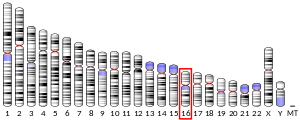Trinucleotide repeat-containing gene 6A protein is a protein that in humans is encoded by the TNRC6A gene.[5][6]
This gene encodes a member of the trinucleotide repeat containing 6 protein family. The protein functions in post-transcriptional gene silencing through the RNA interference (RNAi) and microRNA pathways. The protein associates with messenger RNAs and Argonaute proteins in cytoplasmic bodies known as GW-bodies or P-bodies. Inhibiting expression of this gene delocalizes other GW-body proteins and impairs RNAi and microRNA-induced gene silencing.[6]
References
edit- ^ a b c ENSG00000288130 GRCh38: Ensembl release 89: ENSG00000090905, ENSG00000288130 – Ensembl, May 2017
- ^ a b c GRCm38: Ensembl release 89: ENSMUSG00000052707 – Ensembl, May 2017
- ^ "Human PubMed Reference:". National Center for Biotechnology Information, U.S. National Library of Medicine.
- ^ "Mouse PubMed Reference:". National Center for Biotechnology Information, U.S. National Library of Medicine.
- ^ Margolis RL, Abraham MR, Gatchell SB, Li SH, Kidwai AS, Breschel TS, Stine OC, Callahan C, McInnis MG, Ross CA (Jul 1997). "cDNAs with long CAG trinucleotide repeats from human brain". Hum Genet. 100 (1): 114–22. doi:10.1007/s004390050476. PMID 9225980. S2CID 25999127.
- ^ a b "Entrez Gene: TNRC6A trinucleotide repeat containing 6A".
Further reading
edit- Yamagata K, Takeda J, Menzel S, et al. (1996). "Searching for NIDDM susceptibility genes: studies of genes with triplet repeats expressed in skeletal muscle". Diabetologia. 39 (6): 725–730. doi:10.1007/BF00418545. PMID 8781769. S2CID 41411039.
- Bonaldo MF, Lennon G, Soares MB (1997). "Normalization and subtraction: two approaches to facilitate gene discovery". Genome Res. 6 (9): 791–806. doi:10.1101/gr.6.9.791. PMID 8889548.
- Dias Neto E, Correa RG, Verjovski-Almeida S, et al. (2000). "Shotgun sequencing of the human transcriptome with ORF expressed sequence tags". Proc. Natl. Acad. Sci. U.S.A. 97 (7): 3491–3496. Bibcode:2000PNAS...97.3491D. doi:10.1073/pnas.97.7.3491. PMC 16267. PMID 10737800.
- Nagase T, Kikuno R, Ishikawa K, et al. (2000). "Prediction of the coding sequences of unidentified human genes. XVII. The complete sequences of 100 new cDNA clones from brain which code for large proteins in vitro". DNA Res. 7 (2): 143–150. doi:10.1093/dnares/7.2.143. PMID 10819331.
- Eystathioy T, Chan EK, Tenenbaum SA, et al. (2002). "A phosphorylated cytoplasmic autoantigen, GW182, associates with a unique population of human mRNAs within novel cytoplasmic speckles". Mol. Biol. Cell. 13 (4): 1338–1351. doi:10.1091/mbc.01-11-0544. PMC 102273. PMID 11950943.
- Strausberg RL, Feingold EA, Grouse LH, et al. (2003). "Generation and initial analysis of more than 15,000 full-length human and mouse cDNA sequences". Proc. Natl. Acad. Sci. U.S.A. 99 (26): 16899–16903. Bibcode:2002PNAS...9916899M. doi:10.1073/pnas.242603899. PMC 139241. PMID 12477932.
- Eystathioy T, Chan EK, Mahler M, et al. (2004). "A panel of monoclonal antibodies to cytoplasmic GW bodies and the mRNA binding protein GW182". Hybrid. Hybridomics. 22 (2): 79–86. doi:10.1089/153685903321947996. PMID 12831532.
- Eystathioy T, Jakymiw A, Chan EK, et al. (2003). "The GW182 protein colocalizes with mRNA degradation associated proteins hDcp1 and hLSm4 in cytoplasmic GW bodies". RNA. 9 (10): 1171–1173. doi:10.1261/rna.5810203. PMC 1370480. PMID 13130130.
- Eystathioy T, Chan EK, Takeuchi K, et al. (2004). "Clinical and serological associations of autoantibodies to GW bodies and a novel cytoplasmic autoantigen GW182". J. Mol. Med. 81 (12): 811–818. doi:10.1007/s00109-003-0495-y. PMID 14598044. S2CID 31604559.
- Ota T, Suzuki Y, Nishikawa T, et al. (2004). "Complete sequencing and characterization of 21,243 full-length human cDNAs". Nat. Genet. 36 (1): 40–45. doi:10.1038/ng1285. PMID 14702039.
- Gerhard DS, Wagner L, Feingold EA, et al. (2004). "The status, quality, and expansion of the NIH full-length cDNA project: the Mammalian Gene Collection (MGC)". Genome Res. 14 (10B): 2121–2127. doi:10.1101/gr.2596504. PMC 528928. PMID 15489334.
- Yang Z, Jakymiw A, Wood MR, et al. (2005). "GW182 is critical for the stability of GW bodies expressed during the cell cycle and cell proliferation". J. Cell Sci. 117 (Pt 23): 5567–5578. doi:10.1242/jcs.01477. PMID 15494374.
- Sen GL, Blau HM (2005). "Argonaute 2/RISC resides in sites of mammalian mRNA decay known as cytoplasmic bodies". Nat. Cell Biol. 7 (6): 633–636. doi:10.1038/ncb1265. PMID 15908945. S2CID 6085169.
- Rehwinkel J, Behm-Ansmant I, Gatfield D, Izaurralde E (2005). "A crucial role for GW182 and the DCP1:DCP2 decapping complex in miRNA-mediated gene silencing". RNA. 11 (11): 1640–1647. doi:10.1261/rna.2191905. PMC 1370850. PMID 16177138.
- Jakymiw A, Lian S, Eystathioy T, et al. (2006). "Disruption of GW bodies impairs mammalian RNA interference". Nat. Cell Biol. 7 (12): 1167–1174. doi:10.1038/ncb1334. PMID 16284622. S2CID 36630239.
- Liu J, Rivas FV, Wohlschlegel J, et al. (2006). "A role for the P-body component GW182 in microRNA function". Nat. Cell Biol. 7 (12): 1161–1166. doi:10.1038/ncb1333. PMC 1804202. PMID 16284623.
- Lian S, Jakymiw A, Eystathioy T, et al. (2007). "GW bodies, microRNAs and the cell cycle". Cell Cycle. 5 (3): 242–245. doi:10.4161/cc.5.3.2410. PMID 16418578.
- Behm-Ansmant I, Rehwinkel J, Doerks T, et al. (2006). "mRNA degradation by miRNAs and GW182 requires both CCR4:NOT deadenylase and DCP1:DCP2 decapping complexes". Genes Dev. 20 (14): 1885–1898. doi:10.1101/gad.1424106. PMC 1522082. PMID 16815998.
- Schneider MD, Najand N, Chaker S, et al. (2006). "Gawky is a component of cytoplasmic mRNA processing bodies required for early Drosophila development". J. Cell Biol. 174 (3): 349–358. doi:10.1083/jcb.200512103. PMC 2064231. PMID 16880270.



